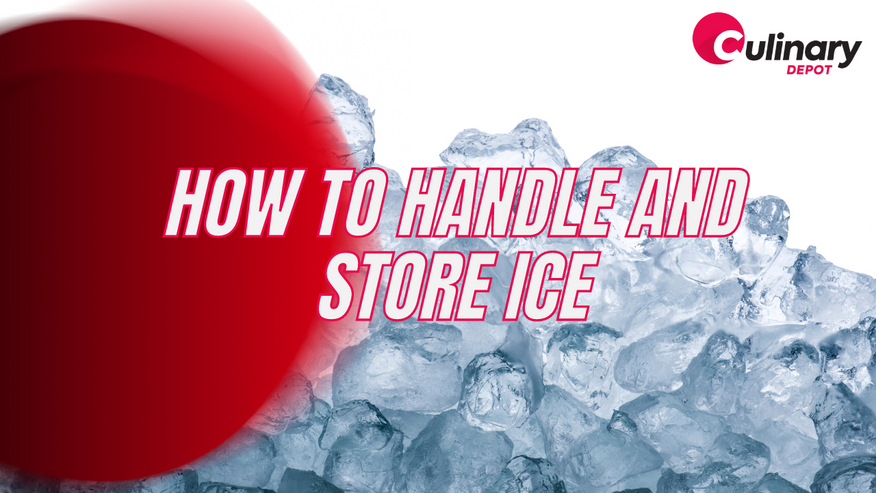Jul 26th 2023 - Team Member
The Comprehensive Guide: How Should You Handle and Store Ice in Commercial Kitchens
Ice plays a pivotal role in food service operations, crucial for keeping ingredients fresh, and beverages cool, and for use in culinary creations. Despite its ubiquity, ice, a classified food under the Food and Drug Administration (FDA), often doesn't receive the same standard of care as other food items.
Guidelines for Safe Ice Handling
The rules for ice handling aren't complicated. They involve personal hygiene, correct use of tools, proper storage, and routine maintenance of ice machines.
Personal Hygiene: Always Start with Clean Hands

Before working with ice, ensure your hands are clean—washed thoroughly for at least 20 seconds in warm water with soap. As a general rule, avoid handling ice or any food item when you're unwell, particularly if you're experiencing symptoms such as vomiting or diarrhea.
Use Tools: Scoops and Tongs are Your Friends
Always use utensils like scoops and tongs when handling ice—never use your bare hands. These tools should be cleaned and sanitized before use and stored in a safe area to prevent contamination. Importantly, never use a glass to scoop ice.
Proper Ice Storage: The Do's and Don'ts
When storing ice, use specific containers that have been cleaned and sanitized. Label these containers properly, and when not in use, store them upside-down to prevent contamination.
Ice Machine Maintenance: Keep Them Clean and Secure

Regular inspection and maintenance of ice machines are crucial to ensure their cleanliness and proper function. Lock ice machines to prevent tampering and avoid storing potential contaminants like recycling bins, dirty dishes, or garbage cans near them.
Scotsman UC2724SA-1
The Importance of Cleanliness in Ice Handling
As an integral part of food service, ice deserves meticulous attention to hygiene. Hands or glasses, though seemingly harmless, harbor bacteria and pose risks of cross-contamination. Therefore, ice should only be touched with sanitized, dedicated tools such as an ice scoop or tongs. Ensuring these practices guards your ice against potential foodborne illnesses.
Frequent Sanitization of Tools
To maintain optimal cleanliness, regularly clean and sanitize ice handling tools. Depending on the frequency of use, a daily or bi-daily sanitization schedule may be appropriate.
Maintenance of Ice Machines
Ice machines can become breeding grounds for bacteria and mold if not maintained properly. Regular cleaning and descaling, in accordance with the machine manufacturer's instructions, prevent such issues, ensuring safe ice production.
Recommended Cleaning Frequency

While the exact frequency varies between models and manufacturers, a good rule of thumb is to clean the machine at least every six months. This frequency might need to be increased depending on your local water quality and usage volume.
Preserving the Perfect Temperature
Storing ice at 0°C (32°F) or below is key to maintaining its form. Consistent temperatures prevent unnecessary melting and refreezing, which can degrade the quality of the ice and potentially introduce contaminants.
Insulating Ice Storage Containers
Using insulated storage containers helps maintain a consistent temperature, preserving the integrity of the ice.
Storing Ice Safely
Using Clean, Covered Containers
Ice should be stored in sanitized, covered containers. The lid protects the ice from potential airborne contaminants and slows the melting process.
Location Matters
Storing ice away from strong odors or potentially contaminating substances is essential. Ice easily absorbs odors, which can lead to unpleasant tastes.
Adhering to FIFO (First-In, First-Out)

Ice should be used based on its production time. New ice should not be mixed with older batches. This prevents ice from staying in storage for too long, reducing the risk of contamination.
Avoiding Re-Freezing
Refreezing melted ice concentrates any impurities or contaminants that might have been present. Discard any ice that has partially or fully melted instead of refreezing it.
Speed is Key: Use Ice Quickly
Ice should be used quickly once removed from the freezer or ice machine. This practice limits the opportunity for ice to melt and potentially become contaminated.
Understanding Types of Contamination in Ice
The three types of food contamination—biological, physical, and chemical—can also affect ice. Here are some examples:

- Biological Contamination: This can occur if a food handler touches ice with their bare hands.
- Physical Contamination: This can happen if an object falls into the ice container.
- Chemical Contamination: This could result from cleaning chemicals used on ice machines or storage containers.
Cross-contamination is another issue, arising from contaminated ice machines or storage containers, or from the tools used to scoop or portion ice. Therefore, handling ice should follow the same rigorous standards as handling food.
Packaging Considerations
When buying packaged ice, check that the bag is properly sealed and that the ice looks clean and clear. Checking the manufacturing and expiration dates, if available, ensures freshness and safety.
The Importance of Employee Training

Employee training is paramount to ensure all team members understand and implement proper ice handling and storage practices. Regular refreshers can help maintain high standards and ensure everyone is on the same page.
Conclusion
In the bustling environment of a commercial kitchen, the humble ice cube often gets overlooked. But understanding and implementing proper handling and storage techniques can vastly improve the quality of your ice and the safety of your food service operation. Remember, when it comes to ice, treat it as you would any other food—with care, attention, and respect.
By adhering to these guidelines, you can serve ice with confidence, knowing you're providing the safest, highest-quality product to your customers.

